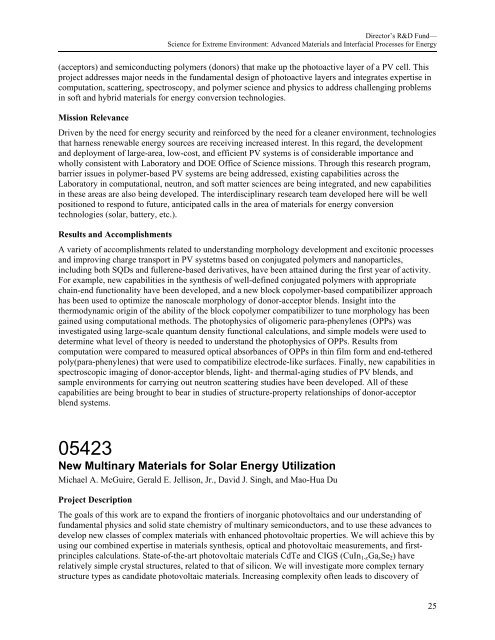FY2010 - Oak Ridge National Laboratory
FY2010 - Oak Ridge National Laboratory
FY2010 - Oak Ridge National Laboratory
You also want an ePaper? Increase the reach of your titles
YUMPU automatically turns print PDFs into web optimized ePapers that Google loves.
Director’s R&D Fund—<br />
Science for Extreme Environment: Advanced Materials and Interfacial Processes for Energy<br />
(acceptors) and semiconducting polymers (donors) that make up the photoactive layer of a PV cell. This<br />
project addresses major needs in the fundamental design of photoactive layers and integrates expertise in<br />
computation, scattering, spectroscopy, and polymer science and physics to address challenging problems<br />
in soft and hybrid materials for energy conversion technologies.<br />
Mission Relevance<br />
Driven by the need for energy security and reinforced by the need for a cleaner environment, technologies<br />
that harness renewable energy sources are receiving increased interest. In this regard, the development<br />
and deployment of large-area, low-cost, and efficient PV systems is of considerable importance and<br />
wholly consistent with <strong>Laboratory</strong> and DOE Office of Science missions. Through this research program,<br />
barrier issues in polymer-based PV systems are being addressed, existing capabilities across the<br />
<strong>Laboratory</strong> in computational, neutron, and soft matter sciences are being integrated, and new capabilities<br />
in these areas are also being developed. The interdisciplinary research team developed here will be well<br />
positioned to respond to future, anticipated calls in the area of materials for energy conversion<br />
technologies (solar, battery, etc.).<br />
Results and Accomplishments<br />
A variety of accomplishments related to understanding morphology development and excitonic processes<br />
and improving charge transport in PV systetms based on conjugated polymers and nanoparticles,<br />
including both SQDs and fullerene-based derivatives, have been attained during the first year of activity.<br />
For example, new capabilities in the synthesis of well-defined conjugated polymers with appropriate<br />
chain-end functionality have been developed, and a new block copolymer-based compatibilizer approach<br />
has been used to optimize the nanoscale morphology of donor-acceptor blends. Insight into the<br />
thermodynamic origin of the ability of the block copolymer compatibilizer to tune morphology has been<br />
gained using computational methods. The photophysics of oligomeric para-phenylenes (OPPs) was<br />
investigated using large-scale quantum density functional calculations, and simple models were used to<br />
determine what level of theory is needed to understand the photophysics of OPPs. Results from<br />
computation were compared to measured optical absorbances of OPPs in thin film form and end-tethered<br />
poly(para-phenylenes) that were used to compatibilize electrode-like surfaces. Finally, new capabilities in<br />
spectroscopic imaging of donor-acceptor blends, light- and thermal-aging studies of PV blends, and<br />
sample environments for carrying out neutron scattering studies have been developed. All of these<br />
capabilities are being brought to bear in studies of structure-property relationships of donor-acceptor<br />
blend systems.<br />
05423<br />
New Multinary Materials for Solar Energy Utilization<br />
Michael A. McGuire, Gerald E. Jellison, Jr., David J. Singh, and Mao-Hua Du<br />
Project Description<br />
The goals of this work are to expand the frontiers of inorganic photovoltaics and our understanding of<br />
fundamental physics and solid state chemistry of multinary semiconductors, and to use these advances to<br />
develop new classes of complex materials with enhanced photovoltaic properties. We will achieve this by<br />
using our combined expertise in materials synthesis, optical and photovoltaic measurements, and firstprinciples<br />
calculations. State-of-the-art photovoltaic materials CdTe and CIGS (CuIn 1-x Ga x Se 2 ) have<br />
relatively simple crystal structures, related to that of silicon. We will investigate more complex ternary<br />
structure types as candidate photovoltaic materials. Increasing complexity often leads to discovery of<br />
25
















